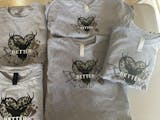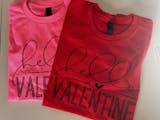In today’s fast-paced customization industry, innovation is key. Transfer printing, a versatile and creative process, has emerged as a go-to solution for transferring designs onto various surfaces. Whether you’re personalizing apparel, creating promotional products, or crafting home décor, transfer printing offers exceptional detail, vibrant colors, and durability. With the introduction of Direct-to-Film (DTF) printing, this method has reached new heights, making it even more accessible and efficient.
What is Transfer Printing?
Transfer printing is a process where designs are transferred from a medium, like transfer paper or film, onto a surface using heat and pressure. This technique delivers vivid, high-quality images that adhere seamlessly to fabrics, ceramics, wood, and more. DTF technology takes this process to the next level, allowing for detailed designs on diverse fabrics with minimal effort.
How Does Transfer Printing Work?
- Artwork Preparation: Designs are created using graphic design software and printed on transfer media.
- Transfer Process: Heat and pressure bond the design to the substrate.
- Final Product: The result is a vibrant, durable image integrated with the material.
DTF printing enhances traditional transfer printing by utilizing a special PET film, water-based pigment inks, and an adhesive powder for superior flexibility and washability.

The Benefits of Transfer Printing with DTF
- Versatility: Transfer printing works on a wide range of materials, from fabrics to hard surfaces. DTF printing expands this versatility, making it suitable for cotton, polyester, blends, and even nylon.
- Vibrant and Detailed Designs: Transfer printing delivers sharp images and bold colors. DTF ensures high resolution and precise gradients, perfect for intricate artwork.
- Durability: Designs created through transfer printing resist cracking and fading. DTF transfers stand out with their soft, flexible finish and longevity, even after multiple washes.
- Cost-Effectiveness: Transfer printing, including DTF, is ideal for both small and large production runs, making it accessible to small businesses and independent creators.
Applications of Transfer Printing (Including DTF)
- Custom Apparel: Create personalized t-shirts, hoodies, and more. DTF’s ability to print on dark fabrics and unusual materials gives it a competitive edge.
- Promotional Products: Transfer vibrant designs onto tote bags, aprons or hats for business branding.
- Home Décor: Customize cushions, blankets, or curtains with unique designs.
- Special Events: Design themed products for holidays, parties, and corporate events.
Step-by-Step: Transfer Printing with DTF
- Materials Needed: PET film, DTF printer, adhesive powder, heat press, and substrate.
- Design Creation: Use design software to create high-resolution images.
- Printing: Print the design directly onto PET film using DTF inks.
- Adhesive Application: Apply powdered adhesive to the printed film.
- Heat Pressing: Position the film on the substrate and apply heat and pressure.
- Peel and Finish: Cool the substrate, then peel off the film to reveal the design.
Tips for Successful Transfer Printing
- Invest in Quality Materials: Use premium transfer paper or PET film, inks, and adhesive powder for the best results.
- Test Runs: Test designs on sample materials to ensure quality.
- Follow Guidelines: Adhere to recommended temperature and time settings for heat pressing.

Why Choose Transfer Printing Over Other Methods?
- Screen Printing: While effective for large runs, screen printing is less efficient for intricate, multi-colored designs. Transfer printing, especially DTF, eliminates the need for screens and streamlines the process.
- Direct-to-Garment (DTG): DTG is limited to fabric surfaces, whereas transfer printing works on diverse materials. DTF bridges this gap with the added advantage of printing on challenging fabrics.
- Vinyl Cutting: Vinyl can be time-consuming and lacks the ability to handle fine details. Transfer printing excels in reproducing complex designs.
Future Trends in Transfer Printing
- Eco-Friendly Innovations: Environmentally friendly inks and transfer films are becoming more popular.
- Digital Printing Advancements: High-speed, high-resolution printers are making transfer printing faster and more efficient. DTF technology is at the forefront of this digital revolution.
Conclusion
Transfer printing has revolutionized the customization industry, offering a cost-effective and versatile way to create stunning designs on various materials. With the addition of DTF technology, this process is now more powerful, enabling intricate, durable designs with minimal setup and effort. Whether you’re a small business owner or a creative professional, mastering transfer printing can unlock endless opportunities for personalized projects and branding. Embrace the magic of transfer printing today, and let your creativity shine.








